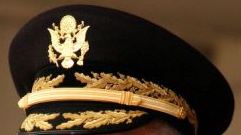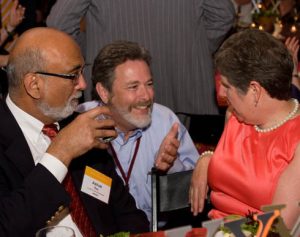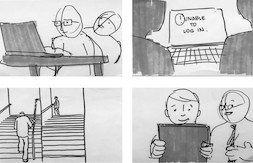 I started this blog in the earlyish days of blogging. I was teaching a course at Northwestern’s Kellogg School about strategic uses of information technology. The blog offered a way to share thoughts with my students. I quickly plugged into a community of like-minded bloggers in education and in knowledge work in general. In time, that network connected me to Buzz Bruggeman, CEO of ActiveWords. Buzz being Buzz, we connected and have remained friends and colleagues since. That is another story in itself.
I started this blog in the earlyish days of blogging. I was teaching a course at Northwestern’s Kellogg School about strategic uses of information technology. The blog offered a way to share thoughts with my students. I quickly plugged into a community of like-minded bloggers in education and in knowledge work in general. In time, that network connected me to Buzz Bruggeman, CEO of ActiveWords. Buzz being Buzz, we connected and have remained friends and colleagues since. That is another story in itself.
ActiveWords is a Windows utility program. On the surface, it is a text substitution tool. Type “aw,†for example and the program will produce “ActiveWords†on the screen. It does much more than that, and there are comparable products on both Windows and Mac. When I was a Windows user, it was one of the first programs I installed on every new computer. I now use equivalents on the Mac.
But this is not a software review.
The default marketing strategy for this category of tool is to emphasize efficiency.The tools invariably come equipped with tools to calculate how much time you save by typing “aw†in place of “ActiveWords.†If you are, in fact, a reasonable touch typist, those time savings are modest. Frankly, they aren’t that great for poor typists. Yet, the people who do adopt these tools often become vocal fans and evangelists. Are theses fans simply horrible typists or are they on to something more interesting?
The marketing from efficiency argument is simple to articulate and deeply rooted in an industrial mindset. Tools are good if they make workers more efficient; Frederick Taylor opined on the size and shape of shovels to improve the efficiency of strong-backed men moving stuff from pile A to box B. Knowledge workers aren’t shoveling coal. None of us work in typing pools.
These tools and their effective (not efficient) use are better understood from the perspective of augmentation laid out by Doug Engelbart. Saving keystrokes isn’t the point; redistributing cognitive load is.
Software developers figured this out long ago and designed programming languages to handle the tedious aspects of building software so that developers could focus on the tricky bits. Bob Frankston and Dan Bricklin wrote Visicalc, the first spreadsheet program, so that they could focus on setting up the finance problem to be solved and let the computer take care of the arithmetic.
There is a conflict here to be managed between knowledge workers and conventional managers. If you are stuck in an efficiency world, you must resist the temptations to cram these approaches into an industrial frame. In an assembly line, the tools are part of the line; everyone uses the same pneumatic tools in the quest for efficiency.
Effectiveness calls for a more personal perspective. You might get away with mandating a standard set of tools —Buzz would be quite happy if Microsoft put a copy of ActiveWords on every Windows machine. But you can’t impose a standard set of abbreviations, for example, on every knowledge worker in the enterprise. That process has to be tailored to each knowledge worker’s individual needs.
Let me offer a simple example. Every time I decide to use the word “individual, †I have to stop and think about how to spell it. That interferes with my train of thought. So, I’ve taught my Mac to transform “indvâ€into “individual.†The program I happed to use for this, TextExpander, will happily calculate how much time I save by typing 4 keystrokes instead of 10, but I don’t care. Maintaining my train of thought is something far more valuable than 6 keystrokes.
Philosopher Alfred North Whitehead captured this calculus long before I learned to type. He observed that:
Civilization advances by extending the number of important operations which we can perform without thinking about them. Operations of thought are like cavalry charges in a battle—they are strictly limited in number, they require fresh horses, and must only be made at decisive moments.
What this does call for is learning to observe our own work and look for the speed bumps and other opportunities to redistribute the cognitive load.

 Synchronicity is real.
Synchronicity is real. What’s the value of experience in the rapidly changing world we inhabit?
What’s the value of experience in the rapidly changing world we inhabit? The tag line for this blog is a quote from Dorothy Parker, “the cure for boredom is curiosity, there is no cure for curiosity.†I chose it on a whim when I started this experiment while I was teaching at the Kellogg School.
The tag line for this blog is a quote from Dorothy Parker, “the cure for boredom is curiosity, there is no cure for curiosity.†I chose it on a whim when I started this experiment while I was teaching at the Kellogg School. Early in my career I knew a little bit and was effective because I was always asking annoying questions to fill in the gaps in my knowledge. In the middle, I thought I knew a fair bit but was often reluctant to share what I did know. The problem then was that I knew enough to realize how much there was to know and knew there was always an expert somewhere who knew more than I did.
Early in my career I knew a little bit and was effective because I was always asking annoying questions to fill in the gaps in my knowledge. In the middle, I thought I knew a fair bit but was often reluctant to share what I did know. The problem then was that I knew enough to realize how much there was to know and knew there was always an expert somewhere who knew more than I did. Application and software vendors are offering more customer support in places like Facebook in addition to their more formal channels. Done well, this enlists volunteer help from users, recreating some of the feel from the earlier days of the online world where there was often a strong sense of shared community.
Application and software vendors are offering more customer support in places like Facebook in addition to their more formal channels. Done well, this enlists volunteer help from users, recreating some of the feel from the earlier days of the online world where there was often a strong sense of shared community. Back in April I started to play with the
Back in April I started to play with the  It was essentially a casting call. I was interviewing retired and semi-retired executives to fill a role in a training simulation we were building. We needed someone to play the part of the client CEO and someone had introduced me to Scott. Scott was a central casting silver fox, tanned from a recent visit to Florida.
It was essentially a casting call. I was interviewing retired and semi-retired executives to fill a role in a training simulation we were building. We needed someone to play the part of the client CEO and someone had introduced me to Scott. Scott was a central casting silver fox, tanned from a recent visit to Florida. “It’s always best to start at the beginning.â€
“It’s always best to start at the beginning.â€